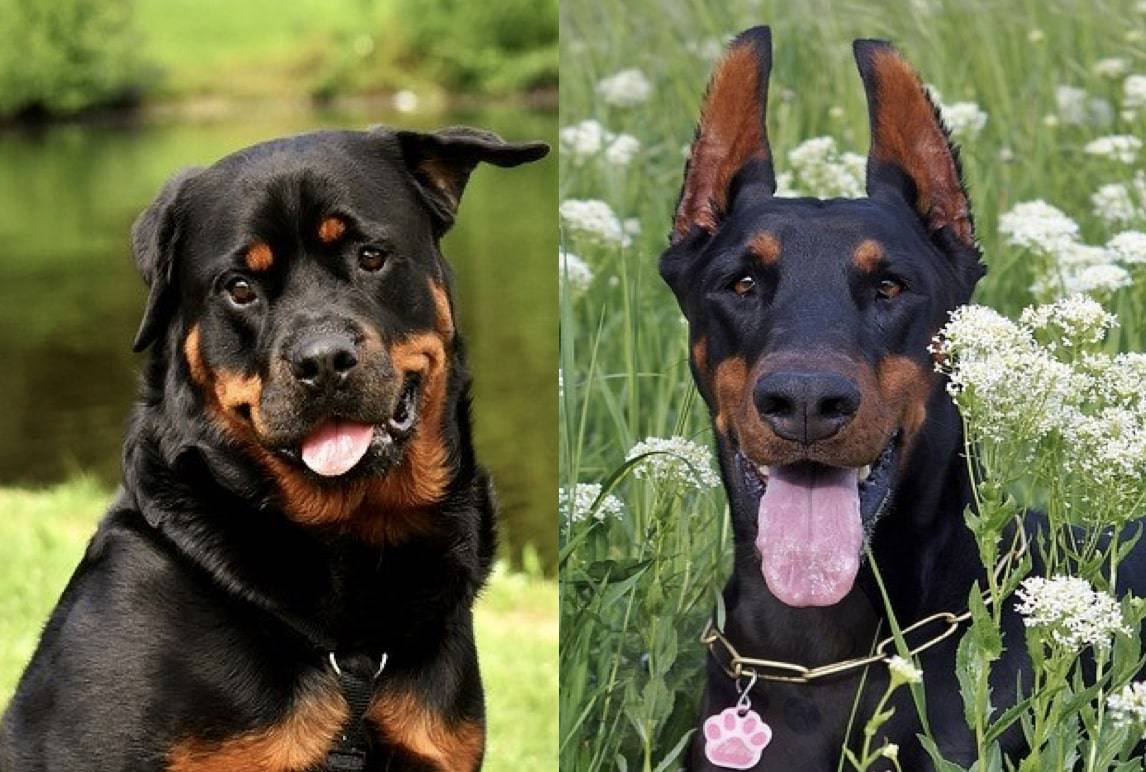The world of dog breeds is rich and diverse, with each breed possessing unique qualities and characteristics. Among the impressive array of breeds, the Rottweiler and the Doberman stand out as two formidable and distinctive choices. In this article, we'll delve into the distinct qualities of the Rottweiler and Doberman breeds, exploring their origins, physical attributes, temperaments, care requirements, and roles in modern society.

Origins and Historical Significance
The Rottweiler and Doberman breeds have distinct historical roles that have shaped their characteristics.
Rottweiler: Versatile Working Dog
The Rottweiler's history is rooted in its role as a versatile working dog. Originally bred to drive cattle and guard livestock, they evolved into dependable protectors and service animals. Their strong work ethic and loyalty made them indispensable partners for farmers and butchers, showcasing their adaptability and dedication.
Doberman: Guardian and Protector
The Doberman's origins trace back to the late 19th century when they were developed by Karl Friedrich Louis Dobermann. Bred to be a guardian and protector, Doberman combined qualities of loyalty, intelligence, and fearlessness. Their role evolved from guarding property to serving in military and police roles, solidifying their reputation as formidable working dogs.

Physical Attributes and Appearances
Both Rottweilers and Dobermans are distinct breeds with unique physical characteristics that reflect their roles and traits. Let's delve into the visual contrasts between these two remarkable breeds.
Rottweiler: Robust and Powerful Build
Rottweilers are known for their impressive stature and muscular physique. With a robust and powerful build, they exude strength and confidence. Their broad chest, strong shoulders, and well-defined muscles showcase their heritage as versatile working dogs. The Rottweiler's signature black coat with distinct rust markings enhances their striking appearance. Their wide head and deep-set eyes contribute to their attentive and protective demeanor.
Doberman: Sleek and Elegant Stature
Dobermans, on the other hand, possess a sleek and elegant stature that radiates athleticism and grace. Their lean body and streamlined features reflect their history as both guard dogs and companions. Dobermans boast a well-proportioned silhouette, showcasing their agility and versatility.
Their coat, which can come in various colors including black, red, blue, and fawn, adds to their unique appeal. The Doberman's wedge-shaped head, intelligent eyes, and cropped ears (when applicable) contribute to their distinctive and alert expression.
Weight and Height
Rottweiler
Rottweilers are a powerful and confident breed known for their loyalty and protective nature. Here are the average weight and height ranges for Rottweilers:
Weight:
- Adult Male: 95 to 135 pounds (43 to 61 kg)
- Adult Female: 80 to 100 pounds (36 to 45 kg)
Height:
- Adult Male: 24 to 27 inches (61 to 69 cm) at the shoulder
- Adult Female: 22 to 25 inches (56 to 63 cm) at the shoulder
Doberman
Dobermans are renowned for their intelligence, athleticism, and versatility as working dogs. Here are the average weight and height ranges for Dobermans:
Weight:
- Adult Male: 75 to 100 pounds (34 to 45 kg)
- Adult Female: 60 to 90 pounds (27 to 41 kg)
Height:
- Adult Male: 26 to 28 inches (66 to 71 cm) at the shoulder
- Adult Female: 24 to 26 inches (61 to 66 cm) at the shoulder
It's important to note that these weight and height ranges are approximate averages for each breed. Individual dogs can vary in size due to genetics, gender, and other factors. When considering a Rottweiler or Doberman, it's advisable to consult with breeders or veterinarians for more specific information about the size of the dog you're interested in.
Temperament and Behavior
The Rottweiler and Doberman breeds have different yet equally remarkable temperaments.
Rottweiler: Loyal and Confident
Rottweilers are renowned for their loyalty and confidence. They are protective of their families and exhibit a calm and steady demeanor. Proper socialization and training channel their natural instincts into being well-behaved companions. Their affectionate nature and natural guarding instincts make them devoted guardians.
Doberman: Alert and Energetic
Dobermans are alert, energetic, and highly trainable. They possess a strong desire to please their owners and excel in various roles. Their intelligence and responsiveness make them versatile working dogs, while their affectionate nature and loyalty endear them to their families.
Caring for Your Rottweiler or Doberman
Caring for a Rottweiler or Doberman involves meeting their specific needs for a happy and healthy life.
Exercise and Mental Stimulation
Both breeds require regular exercise and mental stimulation to thrive. Engaging in activities such as daily walks, play sessions, and interactive games satisfies their physical and mental requirements. Mental enrichment through training and problem-solving tasks keeps their minds sharp and engaged.
Grooming and Health Considerations
Grooming needs vary between the two breeds. Rottweilers have a short coat that requires minimal grooming, while Dobermans have a smooth coat that also requires regular brushing. Regular veterinary check-ups, a balanced diet, and preventive health measures contribute to their overall well-being.
Training and Enrichment
Rottweilers and Dobermans are renowned for their intelligence and willingness to learn. However, their training approaches and enrichment needs can vary based on their individual characteristics. Let's delve into the training aspects of these two remarkable breeds.

Rottweiler: Strong-Willed and Intelligent
Rottweilers possess a strong-willed nature and inherent intelligence that requires focused and consistent training. They thrive under leadership and structured guidance. Early socialization is essential to help them develop positive interactions with people and other animals.
Positive reinforcement methods, such as treats and praise, work effectively with Rottweilers. Their protective instinct can be harnessed through controlled training, making them excellent guard dogs when properly trained.
Doberman: Obedient and Quick Learner
Dobermans are known for their quick learning abilities and strong desire to please their owners. They have a natural inclination towards obedience training and thrive on mental challenges.
Positive reinforcement techniques, such as rewards and praise, are highly effective with Dobermans. They are responsive to cues and commands, making them suitable for various dog sports and activities that require precision and focus. Early socialization and ongoing training contribute to their well-rounded behavior.
Enrichment Activities
Both Rottweilers and Dobermans benefit from mental and physical enrichment activities to keep their minds stimulated and prevent boredom:
- Puzzle Toys: Provide interactive puzzle toys that challenge their problem-solving skills and engage their cognitive abilities.
- Agility Training: Both breeds enjoy agility courses that test their agility and responsiveness to commands.
- Obedience Training: Regular training sessions, including obedience commands and tricks, help keep their minds active and reinforce their bond with you.
- Physical Exercise: Engage in regular physical activities such as daily walks, jogging, or fetch to meet their exercise needs.
- Socialization: Expose them to various environments, people, and animals to build their confidence and social skills.
Roles in Modern Society
Both breeds have found roles in modern society that capitalize on their unique strengths.
Rottweiler: Working Partner and Family Companion
Rottweilers continue to serve as working partners in various capacities, including search and rescue, therapy work, and service roles. Their loyalty and versatility also make them cherished family companions who provide love, protection, and unwavering devotion.
Doberman: Versatile Guardian and Service Dog
Dobermans excel as guardians, protection dogs, and service animals. Their alertness, agility, and trainability equip them for tasks ranging from police work to therapy roles. Their adaptability allows them to transition seamlessly between various roles.
Myths and Realities
Rottweilers and Dobermans are two breeds that often capture people's attention due to their striking appearances and distinct personalities. However, several myths and misconceptions surround these breeds. Let's separate fact from fiction and explore the truths about Rottweilers and Dobermans.
1. Myth: Rottweilers are Inherently Aggressive
Reality: While Rottweilers have a protective nature and can be loyal guardians, they are not inherently aggressive. Proper training, socialization, and responsible ownership play crucial roles in shaping their behavior. With appropriate guidance, Rottweilers can be well-mannered and affectionate companions.
2. Myth: Dobermans are Dangerous Attack Dogs
Reality: Dobermans are intelligent and loyal dogs that have been unfairly stereotyped as aggressive attack dogs. In reality, their temperament is influenced by their upbringing and training. Well-socialized Dobermans are often gentle and make excellent family pets.
3. Myth: Rottweilers Need Excessive Exercise
Reality: While Rottweilers are energetic dogs, they do not require excessive exercise. Regular walks, playtime, and mental stimulation are sufficient to keep them healthy and content. Over-exercising can lead to joint issues, so moderation is key.
4. Myth: Dobermans are Hard to Train
Reality: Dobermans are highly intelligent and eager to please, making them receptive to training. They thrive on positive reinforcement methods and enjoy mental challenges. Consistent training can result in a well-behaved and obedient Doberman.
5. Myth: Rottweilers are Not Suitable for Families
Reality: Rottweilers can be wonderful family dogs when raised in a loving and well-structured environment. Early socialization and training help them develop positive interactions with both family members and other pets.
6. Myth: Dobermans are Only Good for Guarding
Reality: While Dobermans excel at guard and protection work due to their loyalty and alertness, they are versatile dogs that can also be loving companions, therapy dogs, and successful in dog sports.

Community and Engagement
Engaging with Rottweiler and Doberman enthusiast groups adds to the experience of owning these breeds.
Rottweiler and Doberman Enthusiast Groups
Numerous enthusiast groups and clubs are dedicated to Rottweilers and Dobermans. These communities provide opportunities to connect with experienced owners, share insights, and learn from others who understand the unique qualities of these breeds.
Sharing Experiences and Insights
Sharing your journey with Rottweilers and Dobermans not only enriches the bond between you and your dog but also contributes to the collective knowledge of the breed. Your experiences, tips, and anecdotes can guide and inspire fellow owners.
Adopting a Rottweiler or Doberman
Adopting a Rottweiler or Doberman is a significant decision that requires careful consideration.
Research and Education
Before adopting, research the breed thoroughly to understand their needs, temperament, and care requirements. Education about responsible ownership ensures a fulfilling and positive experience.
Finding a Reputable Source
When adopting, choose a reputable breeder or rescue organization that prioritizes the health and well-being of their dogs. Responsible sourcing contributes to the overall welfare of the breed.
Comparing Average Pricing: Rottweiler vs. Doberman
Rottweiler
Rottweilers are robust and loyal dogs known for their protective nature. The average price of a Rottweiler can vary based on factors such as breeder reputation, lineage, and location. On average, you can expect to pay between $1,000 and $2,500 for a Rottweiler puppy from a reputable breeder. Prices can also be influenced by the dog's pedigree and whether the puppy is intended for pet, show, or breeding purposes.

Doberman
Dobermans are intelligent and versatile dogs with a strong work ethic. Similar to Rottweilers, the average price of a Doberman can vary depending on factors such as breeder reputation, bloodline, and geographic location. On average, Doberman puppies from reputable breeders may range from $1,500 to $2,500. Show-quality or breeding-quality puppies can be priced higher.
It's important to note that these price ranges are estimates and can vary based on market demand, availability, and other factors. When purchasing a Rottweiler or Doberman, it's recommended to work with responsible breeders who prioritize the health and well-being of their dogs.
Additionally, adopting a Rottweiler or Doberman from rescue organizations or shelters is a compassionate and cost-effective option, as adoption fees are generally lower and include essential medical procedures.
Conclusion
The Rottweiler and Doberman breeds are embodiments of strength, loyalty, and distinct capabilities. By understanding their origins, meeting their needs, and embracing their unique qualities, you embark on a journey of companionship that is as fulfilling as it is enriching.
FAQs
1. Are Rottweilers good with children?
Yes, Rottweilers can be great with children when properly socialized and trained. Their natural protective instincts often extend to the entire family.
2. Can Dobermans live in apartments?
Yes, Dobermans can adapt to apartment living if provided with sufficient exercise and mental stimulation.
3. Do Rottweilers and Dobermans get along with other pets?
Proper socialization is key. With early introduction and training, both breeds can coexist with other pets.
4. Are Rottweilers and Dobermans prone to health issues?
While both breeds can be susceptible to certain health concerns, responsible breeding, proper care, and regular veterinary check-ups can mitigate risks.
5. Do Rottweilers and Dobermans require professional training?
While professional training can be beneficial, both breeds can be trained effectively through positive reinforcement methods and consistent effort from their owners.




